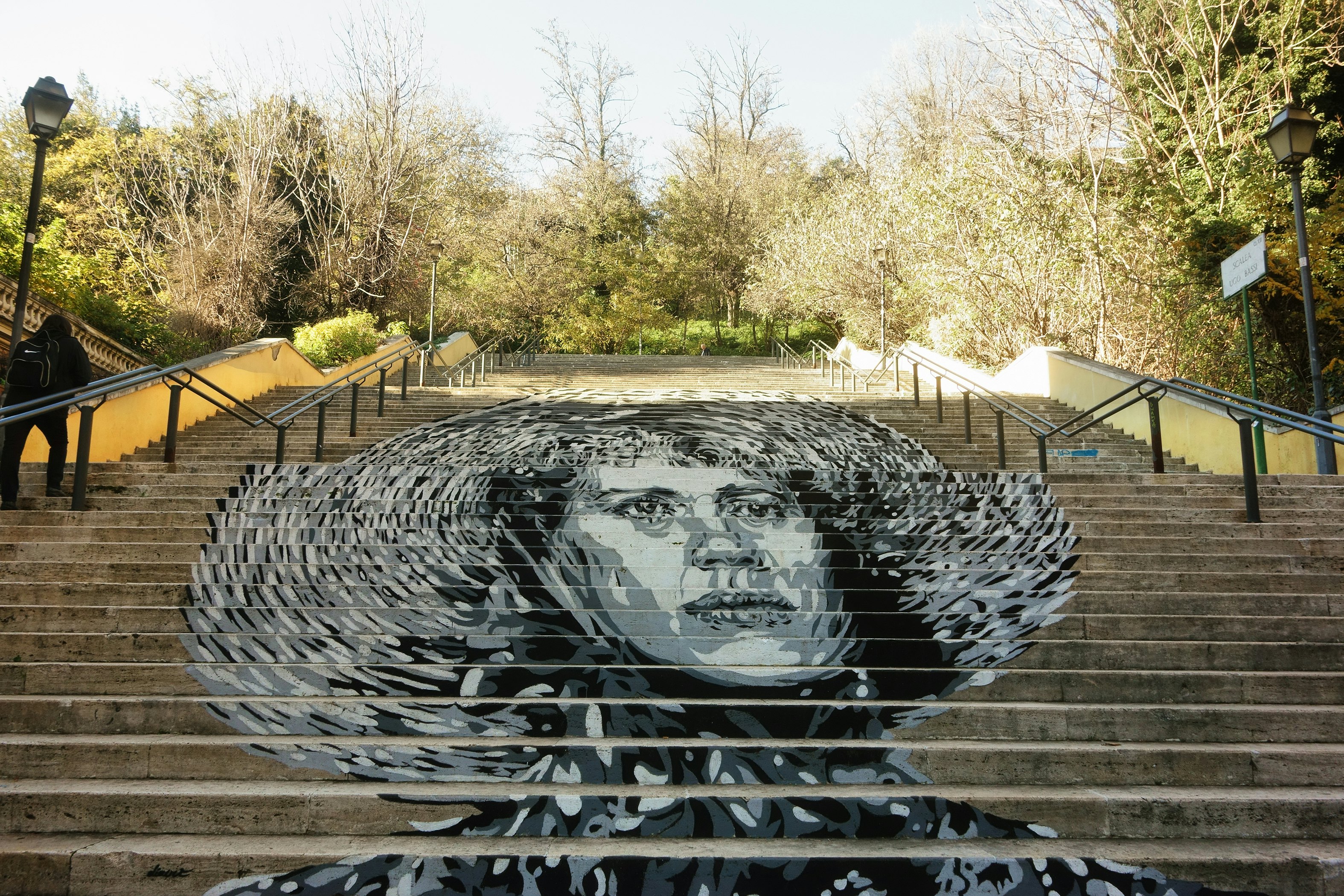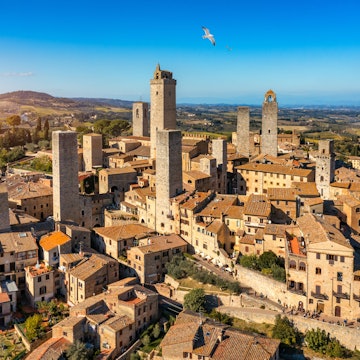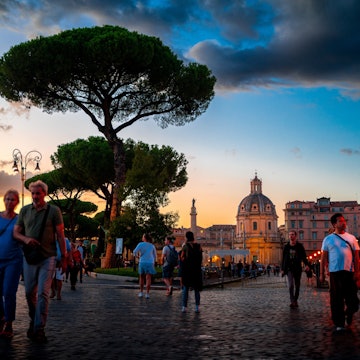
Rome's best neighborhoods: where to stay and what to do

Nov 14, 2025 • 10 min read

Piazza San Cosimato Market in Rome's Trastevere neighborhood. Getty Images
What makes a city? Beyond the monuments and symbols that come to define points on a map, cities draw us in because of the life that courses through them. Almost no city does this better than Rome.
So whether you’re a first-time traveler or a seasoned veteran, you cannot help but be seduced by the city’s enchanting, bewildering, infuriating contours. Rome is a city that seems to defy even time itself – there’s a reason they call it the Eternal City.
The alchemy that breathes life into Rome isn’t only found in its iconic statues and shrines. Yes, you’ll want to stand awestruck in front of the Colosseum, or brave the crowds to stand beneath the cupola of the Pantheon. You’ll be tempted to wade through the Trevi Fountain – don’t! – and join the legions that pass through alleys to emerge victorious at the Spanish Steps.
But if you really want to find the real Rome, branch out of the historic center and spend a bit more time in the different neighborhoods. We could debate Rome’s prettiest streets, parks and piazzas until Roman concrete crumbled, but one of the best things to do in the Italian capital is to find the parts of it that you don’t often see on the cover of magazines.
Here are the six best neighborhoods in Rome to immerse yourself in.

1. Garbatella Storica
Best neighborhood for authentic Roman life
To discover another side of Rome away from the tourist queues, head to Garbatella Storica, one of the most distinct corners of the city. Developed a century ago as a neighborhood for working-class families, Garbatella was based on the English garden city movement – a type of 20th-century urban planning that married housing and ample green space – and as such is filled with unique one- and two-story buildings, many with their own gardens or shared allotments that are still used to grow vegetables and hang laundry. You’ll see families tending their tomato plants or kids playing in the street in distinct buildings known as lotti, public housing that has made the neighborhood famous.
While it’s still predominantly a family neighborhood, Garbatella is definitely on the radar: there are bars, restaurants, and venues that truly capture the renegade spirit while bringing their own twist. Have a drink at the iconic Bar Cesaroni after a performance at the equally legendary Palladium Theater. Don’t miss the community-run Casetta Rossa, a unique space that collects funds for needy families and provides resources to immigrants.
Garbatella Storica shows visitors a side of Rome unlike any other. It's a 15-minute metro ride on the B line from the center of the city, or you can choose to walk there in about an hour.
Where to stay: Hotel Abitart features changing contemporary art exhibitions by a local Roman artist to decorate its stylish mid-sized hotel. It is located in the adjacent and gentrifying neighborhood of Ostiense.

2. Ostiense and San Lorenzo
Coolest neighborhood in Rome
There’s a lot of debate about the coolest neighborhood in Rome – and with good reason. From dips in the Trevi Fountain in Federico Fellini’s great film La Dolce Vita to wild-haired Vespa rides, the Eternal City may just be the birthplace of cool. But let’s face it, you’re unlikely to run into many hip Romans if you spend most of your time waiting in line with a bunch of tourists. Instead, head south of the Aventino to Ostiense, famous for its unmistakable Pyramid.
If you visit Wednesday to Sunday you can rummage through the treasures at the Città Ecosolidale, a sprawling vintage market managed by the lay community of Sant’Egidio.
Ostiense is great for gourmands as well. Seek out the elevated yet chic Trattoria Pennestri, and plant-based refuge Romeow Cat Bistrot. Just behind the Roman walls, to the east of Termini station, is San Lorenzo. Formerly a gritty working neighborhood – and then a slightly grimy student spot – the area has since become a destination in its own right. Now one of the best places to check out street art in Rome, you’ll find work by local heroes like Alice Pasquini, whose vivid depiction of women runs the length of via dei Sabelli, to the mural Elisa Caracciolo created for International Womens Day in 2012 as a tribute to those who lost their lives to domestic violence. It’s proof that art is alive and well in Rome beyond its famous museums.
Where to stay: Hotel Abitart is right near Roma Ostiense station.

3. Testaccio
Best neighborhood for foodies
There are precious few places left in the world that feel like Testaccio. Framed by a great terracotta mountain and hulking bones of a slaughterhouse-turned-market, Testaccio sits resolutely along the Tiber, just south of the center of Rome. If you’re looking for the kind of place where families sit outside until the wee hours and the sounds of a football match echo through the streets, this is it. If you have ever known what it means to be a city kid, you’ll feel like you’ve finally found your way home again.
Great food is just about everywhere in Rome but if your mind is led by your belly, plan to spend a lot of time in Testaccio. This is the gastronomic heart of the city, with the quinto quarto cuisine ("fifth quarter"; the offal of butchered animals). Try a classic cacio e pepe (cheese and pepper spaghetti) at Felice or Flavio al Velavevodetto, both of which have been around since time immemorial.
For something more contemporary (but not by much), head to Piatto Romano, where the classics get a thoughtful twist and the best things on the menu are actually off the menu (always ask for the specials). Osteria Fratelli Mori promises a raucous dining room and equally bold plates that put modern touches on standards like oxtail and tongue. Taste all this and more at Mercato Testaccio, where you can tell everyone to find you, once you pull up a bench and realize that this is the only part of town you’ll ever need to be.
Where to stay: Just a stone's throw from Testaccio market, the simple, sun-filled modern Sonder is a three-star hotel that offers bright, uncluttered rooms with private balconies. Or try Althea Inn Roof Terrace, an excellent value-for-money B&B offering Art Deco–inspired rooms, some with their own balconies, and easy access to Testaccio’s many trattorias.

4. Prati
Best neighborhood to stay in
Tucked just behind the cupola of St Peter’s Basilica in the Vatican City, the Prati neighborhood is one of Rome’s best- and worst-kept secrets. Bordering the west bank of the Tiber River, Prati is a mix of art nouveau cool and residential quiet that makes it an ideal location for a Roman holiday done the right way. If you’re looking to rub elbows with Romans who nail that mix of effortless cool and impeccable style, you’re in the right place – and if you’re trying to snag a prime spot at the Vatican museums, it helps to be right next door.
Prati also has some of the best shopping in Rome. If you’ve got a suitcase to spare, make your way to via Cola di Rienzo and via Ottaviano, two of the best streets for shopping in the city. Choose from an array of well-known Italian brands like Twinset or tiny shops like Il Bavero where clothes are still cut to measure.
The neighborhood is buzzing with great cafes like Habemus, which is also conveniently located next to the Mercato Trionfale, Rome’s biggest and most varied food hall. Sleep in the budget confines of Mama Shelter and drink at the rooftop bar to save some money. You’ll be front and center for celebrity chef Stefano Callegari’s Romanè, the first restaurant from the man who redefined Roman street food.
Prati is very well connected to the rest of the city via metro B at both the Ottaviano and Cipro stations which will bring you to Termini station in just under 15 minutes. The Lungotevere, a walking and cycling lane that runs along the Tiber, is also found here and offers a spectacular perspective of the city from below.
Where to stay: Simple design with a youthful vibe, Il Plancton is right in the middle of the quiet Prati neighborhood. Or choose, Le Stanze di Orazio, which features five modern, elegant rooms, just a short walk or metro ride from the Vatican.

5. Trastevere
Best neighborhood for families
If you’ve ever had dreams of cobblestone streets and quirky daily scenes, chances are you’ve had Trastevere in your sights. South of Vatican City and separated from the center only by the Tiber River (indeed the name derives from trans Tiberim, or "beyond the Tiber"), Trastevere remains one of the most picturesque and enchanting areas of a city with no shortage of them. In recent years it has become the headquarters for study abroad students living out their own adventures, and it remains a must-see for many day trippers. However if you’re on a family holiday Trastevere may be just the thing.
Eminently walkable with large swaths of pedestrianized streets, Trastevere is most well known for its labyrinth cobblestone streets and major sites like the Basilica di Santa Maria in Trastevere, one of the oldest churches in Rome. Even the crankiest child can’t help but stare in awe at the dazzling frescoes both inside and outside the building.
As much of the neighborhood is pedestrianized, children can safely run around the fountain in the piazza that shares its name with the Basilica. Cars do snake through crowds in some parts, however, so when you need to escape the engines head over to The Botanical Garden of Rome, which features over 7000 plant species and plenty of kid-friendly activities. If that hasn’t tired everyone out, continue up to the Belvedere di Gianicolo, a panoramic terrace atop one of the seven hills of Rome that offers incredible views of the entire city.
The abundance of expats in Trastevere means lots of the neighborhood restaurants have mastered the art of feeding capricious palates, so you’ll find familiar foods with fun local twists at Mammò Street Food and Meccanismo in Piazza Trilussa. Don’t miss Fatamorgana for some of the best (and healthiest, if such a thing can be said) gelato you’ll ever find.
Traveling without little ones? You'll want to join the nightly crowd at Bar San Calisto in the eponymous piazza where you probably won’t get a table but you’ll definitely get a good story (and a great granita). If you fancy some creatively prepared dishes and bottles of natural wine, head over to L’Antidoto for a selection of both.
Where to stay: Trastevere Sweet Rest guesthouse features two simple but elegant and quiet rooms and is the perfect place for bargain hunting at Porta Portese market. Arco del Lauro, nestled in one of Trastevere’s picturesque alleyways, is a six-bedroom guesthouse with parquet floors and well-equipped bathrooms.


6. Pigneto and Centocelle
Best neighborhoods for aperitivo bars
We could probably spend months touring the best aperitivo bars in the city, but the best part of pre-dinner drinks is the spontaneity: one drink turns into three, and the table grows as friends of friends stop by to join in. In many ways, it’s the essence of what makes a neighborhood – and none do aperitivo quite like Pigneto. Think of it as the fount from which hipster San Lorenzo bloomed. Tucked in the tangle of railway lines that crisscross through the heart of the city, Pigneto has been a bulwark of activism and inclusivity for generations. During WWII it was a locus for the antifascist movement and later on a refuge for immigrants and artists alike.
Today, working families live side-by-side with creative misfits, creating a neighborhood so distinct that the famed filmmaker Pier Paolo Pasolini couldn’t help but fall in love with it. Pigneto returned the favor with a series of murals dedicated to Pasolini on via Fanfulla da Lodi, which have become their own destination.
The street art is a perfect backdrop to the irrepressibly buoyant scenes along the Isola Pedonale, a pedestrian area that runs down via del Pigneto offers great food, drinks (the cocktails at Cargo never disappoint), and people-watching. Those really in the know go deeper still into the Centocelle quarter, which feels both like a step back in time and one into a fine future. Get to Legs for Italian fried chicken you never thought possible, or to Fassangue for tartare, sushi and other raw meat delights. Or simply sit for a while at Bar Orazio.
Where to stay: Despite its deceptive name, Blue Hostel is not a hostel but rather a lovely guest house with smart rooms, beamed ceilings, wooden floors and large windows in the adjacent San Lorenzo neighborhood.















